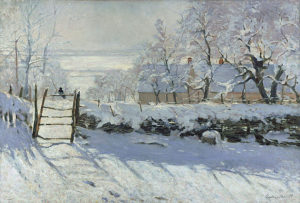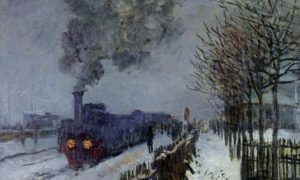Impressionism is often thought of as a system of painting that liberated color. And, we think of its practitioners as men in straw hats, sitting on the sun-dappled banks of the Seine, painting in the plein air.
Something of a surprise then, is a show of many near-monochromatic works, painted by artists who braved the frigid outdoors wearing as many as three overcoats, stamping their feet to keep the circulation going.

Monet: “The Magpie.”
There is, in fact, no contradiction. The impressionists may have liberated color, but that wasn’t their real object. Their fascination was with light, and how to render it chromatically. Snow, with its reflective powers, was nature’s own blank canvas, and, depending on the weather and atmosphere, could display an infinite range of hues and tones, from long blue shadows, to the grays of an overcast day, to the reds of sunset and the dazzling whites of a clear, frigid day.
In addition, snow mutes forms – coating trees, roofs, houses, and fences – and eliminates all the little details that impressionists edited out anyway. Its silence and stillness give the world itself the quality of a painting.
Given all this, one might go so far as to say that winter was the quintessential impressionist season, except, of course, for the hardship of working in it. Indeed, the impressionists developed a special interest in what they called “effets de neige,” or “effects of snow,” the subtitle of the “Impressionists in Winter” exhibit at the Brooklyn Museum, a beautiful show of some 60 paintings organized by the Phillips Collection in Washington. On the last stop of a three-city tour, its arrival here in late spring provides a somewhat surreal refuge from the recent heat.
Winter is here in most all its manifestations. Somewhat under-represented are scenes in which the snow is actually falling. This, we have to assume, is for practical reasons. Painting outdoors in winter is one thing, but snowflakes in the eyes and on the palette are quite another.

Monet: “The Train in the Snow.”
The show’s two stars are Claude Monet and Camille Pissarro, who painted, respectively, 140 and 100 winter scenes over about a 30-year period. Alfred Sisley, the French-born Englishman known for his small, poetic canvases, has a supporting role, as does Gustave Caillebotte, a lesser known impressionist who died of a stroke at 45.
And, there are guest appearances by Paul Cezanne and Paul Gauguin, both of whom did a few snow scenes before departing for the sunnier regions – the south of France and Tahiti, respectively – where they did the work they’re best known for. The buoyant Renoir, who regarded snow as “one of nature’s illnesses,” has only a single picture in the show.
Stylistically, the show has a familiar narrative. The earliest canvases, from the 1860s, are still evolving out of traditional European oil painting. Monet’s “Road by Saint-Simeon Farm in Winter” has echoes of Brueghel’s “Hunters in the Snow,” with its sharp contrasts of dark figures trudging through the snow, crows circling in a pearlescent sky, and the dark, vertical bars of tree trunks set starkly against both snow and sky. By exhibit’s end, Monet has forsaken the device of contrast for prismatic treatments of his boldly simple haystacks, in which the fiery light of sunset is played out against the cool blue of gathering darkness.
Likewise, Pissarro’s sparkling “Road, Winter, Sun and Snow” has the rustic charm of Corot, in which the little figures conferring in the road are bathed in the soft vibratory light of the brilliant blue sky. But, by the 1890s, Pissarro’s semi-pointillist landscapes vibrate to a higher frequency in which sky and snow and tree seem made of molecules of color, as if we were seeing the secret underpinnings of the visible world.
Despite their near-scientific preoccupation with light and visual perception, the impressionists were sensitive to the many moods of winter. There is, for instance, that sense of regeneration that comes when melting snow reveals the muted green vegetation. Such is Monet’s “Road at Louveciennes – Snow Effect.” Something different comes across, however, when the the same scene is translated into early evening: The sunset thaw makes us feel a twinge of sadness for winter’s demise.
A sudden midwinter thaw that began Jan. 3, 1880, and continued for some weeks provided another motif for Monet. Downriver from Monet’s suburban home, this sudden and sustained rise in temperature had disastrous effects. The Seine flooded its banks and huge ice islands destroyed boats and trees. Monet, dedicated purely to the visual phenomenon, saw only the strange beauty of the event.
Although most of these pictures have rural motifs, there are snow scenes of Paris and its environs. Renoir’s “Skaters in the Bois de Boulogne” is a beautiful snowscape, with the smokey green of a fir tree partially framing the grayish overcast scene and animated by hundreds of dark-coated figures socializing and sporting on the ice.
Caillebotte was, like Renoir, drawn to Paris and people. His snow scenes are painted from his studio window, which, in the hardy, adventurous spirit of this show, almost seems like cheating. Nevertheless, he showed he understood the formal challenge of snow effects in his masterful “View of Rooftops (Snow),” with its deep space and its amazing varieties of twilight hues: blues, mauves, violets, and purples.
Sisley surprises in this show for the consistent charm of his pictures. Closer to Pissarro in spirit than to the methodical Monet, his paintings never seem to be about perception. “Snow Effect at Argenteuil” has tiny figures traversing the road in the middle ground, but the painting’s real subject is the foreground’s vast sunken shadow, a cold but irresistible well of melancholy that stands between us and the sparkling zone beyond.
Equally moving is Monet’s “The Red Cape,” in which the view is from a shadowy interior out a tall, curtained window, where the artist’s young wife, Camille, is walking in bulky cloak and red shawl. In passing, she looks in at us. It’s an instant in time, with an added sense of separation, made more poignant by our knowledge that Camille would die young. This painting, and others, is a reminder that for all the impressionists’ emphasis on snow “effects,” it is the mood these effects evoke, the many sides of the darkest and the brightest season, that genuinely touch us.
Brooklyn Museum
1999

